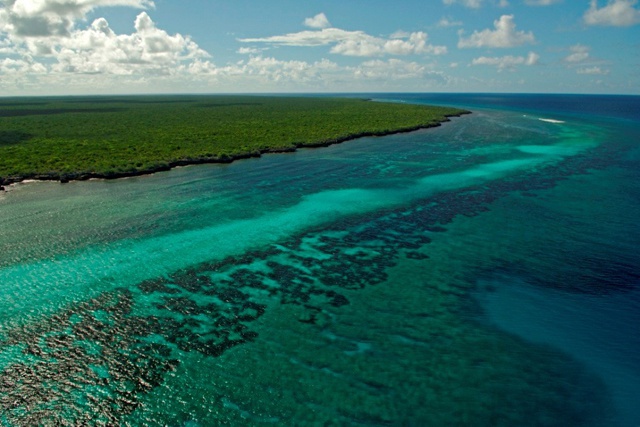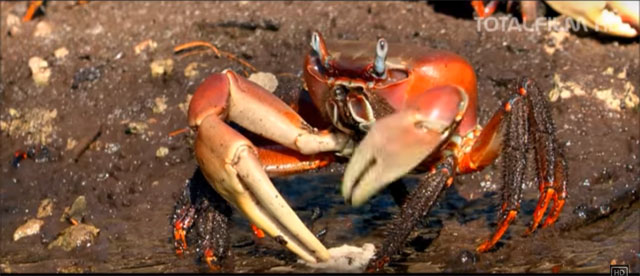A 3D island journey! New movie 'Aldabra' allows Seychelles woman to see land of birth

The incredible outer reef of Aldabra. The terrestrial and marine life of the Seychelles atoll features in a newly released 3D movie. (SIF)
(Seychelles News Agency) - Jenita Brutus, a 72-year-old Seychellois, was born on the archipelago’s most far-flung island. Thanks to the premiere of a new movie, she's gotten her first real glimpse of her land of birth.
Brutus was among the guests invited to the Seychelles premiere on Thursday of a newly released 3D family entertainment movie shot on the Seychelles atoll Aldabra.
The movie -- ‘Aldabra-Once Upon an Island’ -- is giving environment and nature enthusiasts not only in Seychelles but worldwide a feel of what it’s like to actually be on the atoll.
“The birds, crabs, tortoises and other land creatures were all lovely but the undersea world is what I found to be even more beautiful -- and this in spite of my fear of the sea,” Brutus said to SNA on Saturday.
The screening of the movie had been timed to coincide with the welcoming of international carnival participants and media at the newly renovated Deepam Cinema in the Seychelles capital, Victoria.
 |
 |
| Screenshots taken from Youtube Video showing trailer of the 3D movie -- Aldabra Once Upon a Lifetime. (Youtube/Totalfilm.cz) Video License: All Rights Reserved |
Originally set to be a documentary, the film turned out as a family entertainment movie in which robber crabs, Aldabra rails, sharks, sea turtles, and sea creatures have been brought to life.
The movie, which doesn't feature any human characters, tells the story of how Aldabra was formed and how the land and sea creatures adapt to their environment and their daily struggle for survival.
Brutus who was born on Aldabra back in 1944 says she lived there until she was around 2 and a half years.
“I cannot remember anything from that time, so I was very happy to see the movie,” she said. At 72 and considering the remoteness of Aldabra it would now be a bit difficult for her to visit the atoll.
 |
| Jenita Brutus has never been to Aldabra since leaving the atoll two and a half years after she was born. She was among the first people in Seychelles to watch a newly released family entertainment movie about the island. (Brina Brutus) Photo License:All Rights Reserved |
Currently residing at Roche Bois, on the outskirts of Victoria, Brutus explained to SNA how her mum who worked on the atoll at the time could not come down to the main island, Mahé, located some 1,100 from Aldabra, to give birth.
“It was during the time of the war [second World War] and the boats could not be seen coming up and down out of fear of being mistaken for an enemy boat,” said Brutus.
At the time Seychelles was a British colony.
Brutus says she is aware of only one other lady who was born on Aldabra but adds that she recently passed away.
Back in those days men, women and children lived a typical island life on Aldabra harvesting what was available to them including sea turtles, tortoises and seabird eggs.
Today, a UNESCO protected heritage site, the atoll which is managed by a public trust, the Seychelles Island Foundation, is mainly explored and studied by scientists and researchers.
While many dream to take a trip to raised coral atoll, it is indeed costly, hence the reason only a lucky few have had the chance to see first-hand nesting sea turtles, a population of 150 giant land tortoises, black tip sharks swimming in the shallow lagoon live together in harmony.
Seychellois naturalist Pat Matyot was impressed with the modern equipment used for the filming ,which he says has exceeded in capturing “some extremely effective and evocative shots of Aldabra wildlife.”
Nevertheless, Matyot who has been to Aldabra three or four times expressed mixed feelings about the film itself.
While on one hand he says he appreciate its entertainment value adding that this will even capture the attention of people who do not have an interest in science and natural history, he said he did not feel there’s much new actual factual information about Aldabra.
“I think some of the scientific content bordered on the limit of what is factually correct,” said Matyot.
The movie is a 74-minute film derived from what the producers say was 30 hours of raw footage shot in 2012.
 |
 |
 |
| Aldabra's tortoises, rails, robber crabs, turtles, sharks and others have been made to life in the movie which features no human characters. (Youtube/Totalfilm.cz) Video License: All Rights Reserved |
For the Chief Executive of the Seychelles Islands Foundation which manages Aldabra, Dr Frauke Fleischer-Dogley, seeing how the highlights of the atoll have been pieced together is like “ a roller coaster.”
“You go from one scene to the other so I really enjoyed the way it’s been done. The technique used is 3D. You feel like you’re just in the ocean and it’s quite appealing,” she said, adding that the movie will help to promote Aldabra.
The film is currently available in English, Czech and Slovak languages. The producer, Czech businessman Petr Keller, told SNA that it was first premiered in the Czech Republic in November 2015 with 17 weeks of screening.
Asked about the cost, Keller said: “It’s a secret. It’s a lot.”
The movie is now going for a worldwide release and according to the film’s distributor Lise Romanoff from Vision Films, there will also be two screenings at the upcoming Cannes Film Festival in France on May 11 and 16.
| Youtube Video Aldabra - Once Upon an Island (2015) HD trailer. (Youtube/Totalfilm.cz) Video License: All Rights Reserved |
The film’s Director Steve Lichtag has described the filming on Aldabra as very hard and difficult mainly because the island is very far away.
“I would say because it’s real 3D technically it was difficult and complicated to shoot with the animals and to make film is a lot of struggle especially to make a film under water and above water and in a foreign destination, so it’s a double pleasure to bring it to the end and to finally premiere it in the Seychelles,” Lichtag said to SNA.
Lichtag said a 2D documentary about the making of the film would be produced for television.
The unused footage is something SIF’s Chief Executive is also discussing with the producers to be used in another project -- the Aldabra House.
This is a visitor centre dedicated to the Aldabra coral atoll that is expected to be built on the main island, Mahé.
According to Frauke Fleischer Dogley, the concept phase of the project is almost concluded and it’s now going into detailed planning, environment impact assessment phases.
“We hope the planning phase can be concluded this year so that the ground breaking can be latest early 2017.”
While the Aldabra House takes time to materialize, science and nature enthusiasts in Seychelles should have the chance to get an up-close view of the atoll through the movie. Fleischer Dogley told SNA that it’s been understood that Deepam Cinema and the producer have agreed that it will be shown to the general public but that the details still need to be sorted out.





